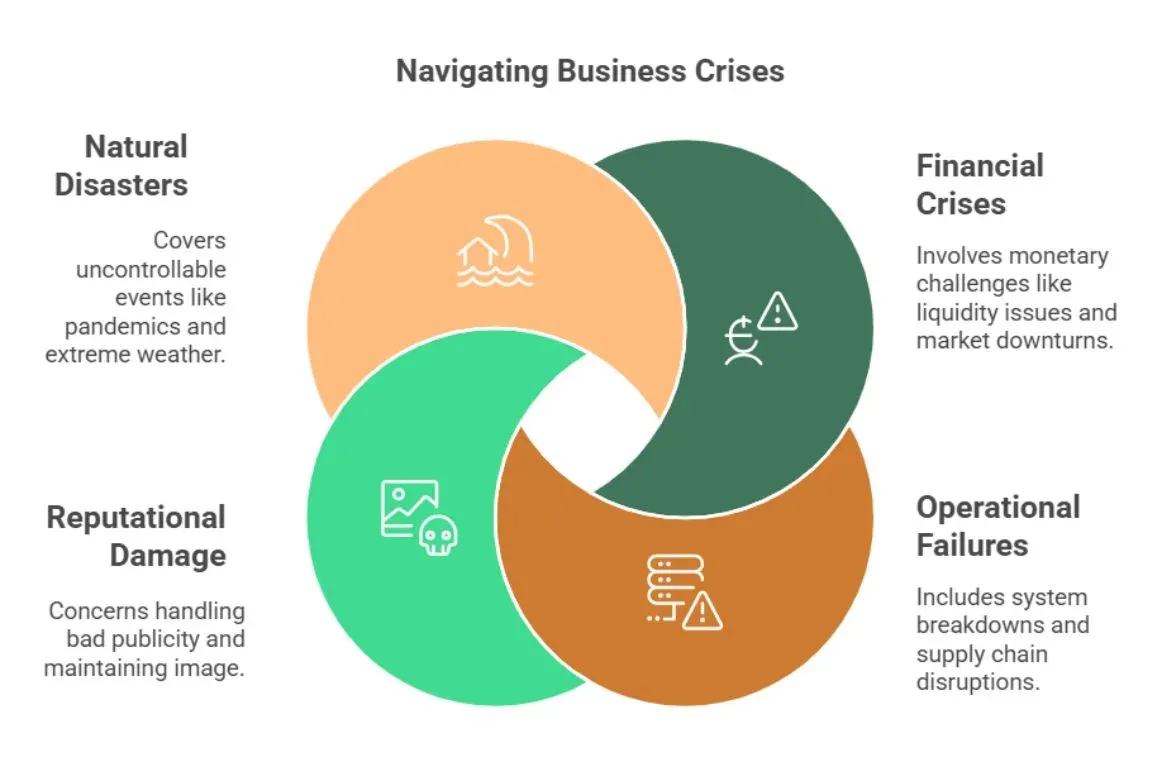Crisis Management: Everything You Need to Navigate Business Emergencies

In today's unpredictable business landscape, organizations must proactively develop comprehensive crisis management strategies to mitigate risks, minimize disruptions, and safeguard their reputation and interests. Since, a single crisis could cost your business millions. LastPass learned this the hard way when their major security breach resulted in £4 million in losses, and many core customers left.
Business crises can hit anytime. Natural disasters, tech failures, or PR nightmares don't discriminate. Even Nike struggled during COVID-19 and lost three months of production when their Vietnam factories shut down.
Smart crisis management doesn't just react to emergencies. Your business needs to spot problems early and create solid plans before they grow. This proactive strategy helps keep your business stable in tough times and protects your reputation, operations, and finances.
What is Crisis Management: Definition and Core Principles
"By failing to prepare, you are preparing to fail." — Benjamin Franklin, Founding Father of the United States
Organizations use crisis management as a systematic way to spot, handle, and bounce back from disrupting events that put their operations, reputation, or stakeholders at risk. A crisis stands apart from regular challenges. It brings a major threat to the organization, comes as a surprise, and leaves little time to make decisions.
Defining business crisis management
Business crisis management has strategies, processes, and protocols that help predict possible threats and respond well when they show up. Investopedia points out that crisis management starts with risk analysis but differs from risk management.
Risk management looks at identifying and reducing possible threats, while crisis management handles these threats before, during, and after they happen.
The impact of crises on organizational stability
A crisis can disrupt an organization at many levels. The effects reach beyond internal aspects like employees, stakeholders, and products. External elements face disruption, too - victims' families, competitors, market share, and maybe even the wider environment.
5 Key principles of effective crisis management

Crisis management works best with these basic principles:
1. Preparedness: A solid plan before a crisis hits stops tunnel vision and emotional decisions. A complete plan has risk assessment, communication protocols, and resource allocation.
2. Ethical leadership: Organizations should stick to their core values and ethical principles. This builds trust with stakeholders, promotes support, and protects brand reputation.
3. Clear communication: Crisis management needs precise, timely, and open communication with everyone involved. Good communication channels help information flow smoothly inside and outside the organization.
4. Decision-making: Leaders must make quick decisions even with conflicting or changing information. They need to stay flexible as situations change.
5. Continuous learning: Teams get stronger at handling crises through training, practice, and learning from experience. This keeps staff ready and capable.
Good crisis management balances quick responses with smart thinking to protect your organization's future.
Developing a Comprehensive Crisis Management Plan
A well-laid-out crisis management plan is the lifeblood of handling emergencies effectively. Your organization needs a solid plan that works as a roadmap through difficult times. This helps you react decisively when crises happen.
Risk assessment and vulnerability analysis
A full picture of risks builds the foundation of any crisis management plan. This process should cover:
- Identifying potential threats unique to your organization, such as natural disasters, data breaches, product recalls, operational accidents, and reputation issues
- Looking at how likely each risk is and what it means for your business
- Getting a clear view of your organization's weak points against these threats
- Using a risk register to focus your response planning efforts
Your vulnerability assessments should look at exposure, sensitivity, and adaptive capacity. This shows how your assets might face potential threats. The results help you figure out where to step in with the right crisis management strategies.
Establishing clear roles and responsibilities
Building a diverse crisis management team becomes crucial next. Your team needs people from public relations, HR, legal, IT, and operations departments. Each team member must know:
- Their authority to make decisions and who they report to
- What they need to do in different crisis situations
- How to communicate with the team and outside world
A roles and responsibilities matrix (RACI chart) makes it clear who decides what in your crisis response plan. This removes any doubt about who does what when time runs short.
Creating response protocols for different crisis types
Your team needs detailed response procedures for various crisis scenarios to act fast. Good protocols should have:
- Clear triggers that show when to start your crisis response
- Detailed action plans for each type of crisis
- Ways to talk to people inside and outside the organization
- Tools to make quick decisions
Regular practice drills and simulations will show any weak spots before real crises hit.
Allocating resources and budget
The right resources make your plan work. Think about setting aside money for:
- Emergency funds you can use right away when needed
- Training your crisis team members
- Technology and communication tools
- Outside help like PR consultants and legal advisors when you need them
Looking at your budget regularly ensures you have enough funds as your organization grows.
Implementing Crisis Management Strategies During an Emergency
"In crisis management, be quick with the facts, slow with the blame." — Leonard Saffir, Public relations expert and author
A crisis demands quick action. The second you spot trouble, your battle-tested plans need to jump off the page into action. Real-time crisis management helps you take charge of events as they unfold and adapt to conditions that change faster than expected.

Activating your crisis management team
Your response starts with getting the right people in place quickly. Those first few minutes can make or break your crisis response, so you need a solid plan to get started. Here's what works:
- Set up emergency alerts through a dedicated crisis phone line with 24/7 support staff
- Make it crystal clear who has management's backing to assess and handle the situation
- Every employee and stakeholder must know exactly who to call for different types of emergencies
The crisis team leader needs to kick off the first meeting right away. They should set clear goals, establish the right tone, spell out what's expected, and confirm everyone's role.
Decision-making frameworks for rapid response
You need a solid game plan to make decisions in a crisis. The OODA Loop (Observe, Orient, Decide, Act) really shines when pressure mounts and things change fast. Here's what you need to master:
Situational awareness – Look at the big picture while you check if your info adds up and figure out what might happen next.
Decisiveness – Keep moving forward even when things get messy or confusing, but stay flexible enough to change course.
Improvization – Know when Plan A isn't working and come up with new options based on what's happening.
Managing internal and external communications
Communication is the lifeblood of crisis management. Your staff should hear the news before the media and other stakeholders do. Here's how to keep everyone in the loop:
- Create a quick statement with the facts you know and tell people when to expect updates
- Make sure everyone in your organization tells the same story to avoid confusion
- Pick one person to be the voice of your company and keep the message consistent
- Let people know exactly when updates will come, even if nothing major has changed
Time matters here. Text alerts can help you reach everyone in your company fast with updates and instructions.
Different Types of Business Crises
Business emergencies take many forms, and each one needs a specific approach to handle well. A good grasp of different crisis types helps you create targeted response strategies.

Financial crises and economic disruptions
Your organization's survival faces serious threats during financial crises. These situations show up as severe monetary challenges like liquidity problems, bankruptcy risks, or sudden market downturns. The stabilization process becomes more complex when these events expose weak spots in balance sheets.
Your priorities during financial crises should be:
- Quick cash control measures that help survival and stop money bleeding
- Well-laid-out performance management plans with clear money targets
- Regular cash flow checks and adjustments that become your key management tool
Financial crises need both quick fixes and longer-term solutions to balance immediate survival with stable financial recovery.
Operational and technological failures
System breakdowns, data breaches, or supply chain disruptions can cripple your daily business operations. These problems happen almost every day now. Banking apps often go down and leave customers stuck without access to their money.
Your operational crisis plan should include:
- Clear identification of vital processes and their acceptable limits
- Solutions for vendor-related risks and possible bottlenecks
- Reliable incident response protocols
Reputational damage and public relations issues
Bad publicity, scandals, or controversies damage your organization's image and create reputation crises. Research shows social media makes things worse - shareholder value drops double from 15% to 30% in the first year after a crisis.
Reputation crises need quick, honest communication instead of avoiding the media. Your crisis team should have clear roles, and all media questions should go through designated spokespersons.
Natural disasters and force majeure events
Natural disasters and "force majeure" events like pandemics or extreme weather disrupt business through uncontrollable circumstances. These events happen more often and hit harder now, so you need ready response plans.
Force majeure contract clauses protect businesses during such events. They excuse parties from achieving obligations when unexpected circumstances make it impossible to perform.
Conclusion
Crisis management is the life-blood of business resilience that just needs strategic foresight and tactical readiness. Your organization's success in weathering storms depends on preparation quality and response effectiveness when facing financial, operational, and reputational challenges.
A resilient crisis management framework just needs these key elements:
- Clear protocols and defined team responsibilities
- Regular risk assessments and vulnerability analyses
- Swift decision-making capabilities
- Effective communication channels
- Resource allocation strategies
Your team's preparedness and knowing how to execute planned responses while staying flexible for unexpected developments will determine successful crisis navigation. Your organization's resilience against threats will strengthen through regular plan reviews, team training, and crisis simulations.
Note that crisis management is an ongoing experience, not a destination. Your crisis management strategy should adapt to new threats and incorporate lessons from past experiences, among other business changes. This proactive approach will protect your organization's future and maintain stakeholder confidence in challenging times.
Prioritizing crisis preparedness offers a competitive advantage and resilience. Management courses prepare professionals to lead technology-driven organizations through strategic management, innovation, and digital transformation, while prioritizing crisis management.
Frequently Asked Questions
Q1. What are the key principles of effective crisis management?
Effective crisis management is built on preparedness, ethical leadership, clear communication, decisive decision-making, and continuous learning. These principles help organizations respond swiftly and appropriately to various emergencies.
Q2. How can businesses develop a comprehensive crisis management plan?
To develop a comprehensive crisis management plan, businesses should conduct thorough risk assessments, establish clear roles and responsibilities, create response protocols for different crisis types, and allocate necessary resources and budgets for implementation.
Q3. What steps should be taken when activating a crisis management team?
When activating a crisis management team, it's crucial to send emergency notifications through designated channels, clearly communicate authority, convene an initial meeting to establish objectives and expectations, and ensure all stakeholders know whom to contact during various crisis types.
Q4. How should organizations manage communications during a crisis?
Organizations should prioritize internal communication before external messaging, establish a holding statement with known facts, ensure coordinated message delivery across the company, designate a spokesperson for consistent communication, and publish regular updates even if there are no significant changes.
Q5. What are the different types of business crises, and how should they be approached?
Business crises can be categorized into financial crises, operational and technological failures, reputational damage, and natural disasters. Each type requires a specific approach, ranging from cash control and performance management for financial crises to transparency and swift response for reputational issues.

TalentSprint
TalentSprint is a leading deep-tech education company. It partners with esteemed academic institutions and global corporations to offer advanced learning programs in deep-tech, management, and emerging technologies. Known for its high-impact programs co-created with think tanks and experts, TalentSprint blends academic expertise with practical industry experience.



